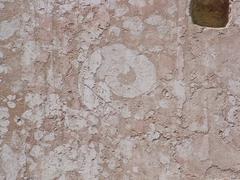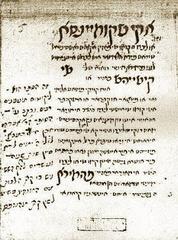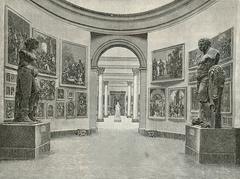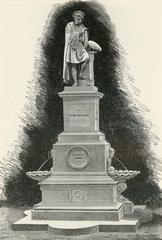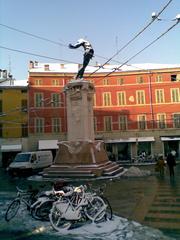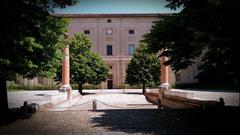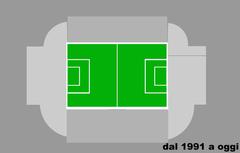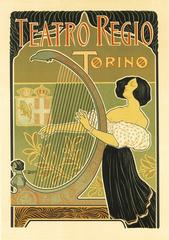Sanctuary of Santa Maria della Steccata: Visiting Hours, Tickets, and Historical Guide – Parma, Italy
Date: 14/06/2025
Introduction
In the heart of Parma, Italy, the Sanctuary of Santa Maria della Steccata stands as a luminous symbol of Renaissance artistry, deep Marian devotion, and historical significance. Originally a late 15th-century oratory built around a miraculous image of the Virgin Mary, the sanctuary has evolved into a major pilgrimage destination and a showcase for Renaissance and Baroque architecture (Comune di Parma; Touring Club Italiano; Nomads Travel Guide).
The basilica, built between 1521 and 1539 on a Greek-cross plan crowned by a majestic dome, reflects the ideals of Renaissance symmetry and harmony. It houses artistic treasures—most notably, Parmigianino’s frescoes of the wise and foolish virgins—alongside works by Michelangelo Anselmi and Bernardino Gatti, and serves as the dynastic mausoleum of the influential Farnese family (Parma Welcome; Opera Parma).
This guide offers a detailed look at the sanctuary’s history, art, and architecture, as well as practical visitor information, including current visiting hours, ticketing, accessibility, and tips for exploring nearby attractions in Parma.
Table of Contents
- Historical Background and Religious Significance
- Architectural Features and Artistic Masterpieces
- Visitor Information
- Nearby Attractions and Cultural Context
- Frequently Asked Questions (FAQ)
- Conclusion and Visitor Tips
- References
Historical Background and Religious Significance
Origins and Architectural Development
The Sanctuary’s origins trace to a small oratory where a revered image of the Virgin Mary drew increasing numbers of pilgrims in the late 1400s. Believed to be miraculous, the image inspired the expansion of the site into a larger sanctuary. Construction began in 1521 under architects Bernardino and Giovanni Francesco Zaccagni, with later input from Gian Francesco d’Agrate and Antonio da Sangallo the Younger. The church was completed in 1539, featuring a pioneering Greek-cross plan and prominent dome, setting a precedent for church architecture in Parma (Comune di Parma; Touring Club Italiano).
The Miraculous Image and Marian Devotion
Central to the sanctuary’s identity is the Madonna della Steccata, named for the protective wooden fence (“steccato”) built around the sacred image. The Madonna’s reputation for miracles, especially during plague and hardship, made the sanctuary a major pilgrimage center. In 1718, Pope Clement XI elevated it to the status of minor basilica, recognizing its religious prominence (Sacred Destinations; GCatholic).
Artistic Heritage and Symbolism
The sanctuary is richly adorned with works by masters of the Italian Renaissance and Mannerism. Parmigianino’s frescoes, especially the wise and foolish virgins, symbolize spiritual vigilance. Other notable contributions include Michelangelo Anselmi’s “Coronation” and Bernardino Gatti’s dome decorations. The church also holds the tombs of the Farnese family, cementing its status as a dynastic mausoleum (Parma Welcome; Opera Parma).
Liturgical Functions and Civic Importance
Santa Maria della Steccata remains an active center for worship, hosting daily Masses, confessions, and major Marian feasts such as the Madonna della Steccata celebration on August 15th. It is also the seat of the Constantinian Order of Saint George, marked by ceremonial events and insignia displays (Sacred Military Constantinian Order of Saint George). Throughout history, the sanctuary has been a place of public prayer during crises and a venue for significant civic ceremonies (Visit Emilia).
Architectural Features and Artistic Masterpieces
Exterior and Plan
The sanctuary’s Greek-cross plan, with four equal arms radiating from a central dome, was innovative for its time and reflects Bramante’s Renaissance influence (Nomads Travel Guide; Opera Parma). Its understated brick exterior, stone detailing, and symmetrical layout create a stately yet welcoming presence in Parma’s cityscape. The dome’s lantern floods the interior with natural light (Opera Parma).
Interior Layout and Lighting
Inside, the centralized plan aligns the four arms with the cardinal points, each ending in a spacious apse. Four corner chapels are dedicated to worship. The play of light—from softly shaded intermediate spaces to the dome’s intense illumination—highlights the sanctuary’s sacred geometry. The grand balustrade by Mauro Oddi (late 17th century) unifies the interior (Nomads Travel Guide).
Artworks by Parmigianino, Anselmi, and Gatti
- Parmigianino: His frescoes above the main altar arch, “The Wise Virgins and the Foolish Virgins,” are among the sanctuary’s most celebrated works. He also painted organ doors and various saints in the north aisle (Nomads Travel Guide).
- Michelangelo Anselmi: Contributed the “Coronation” (1540), bridging Renaissance and Mannerist styles.
- Bernardino Gatti: Designed and decorated the dome (1560), creating a celestial effect that elevates the viewer’s gaze (Opera Parma).
Other treasures include Tommaso Bandini’s Pietà sculpture at the entrance, noble sacristy and choir stalls by GB Mascheroni and Carlo Rottini, and the Theiete Chapel by Jacopo Barozzi da Vignola—resting place of Ottavio Farnese (Emilia Delizia).
Baroque Enhancements and Crypt
Baroque additions have enriched the interior, with ornate stucco and gilding. In 1823, a crypt was added to house the tombs of Farnese and Bourbon Parma family members, reinforcing the sanctuary’s dynastic role (Nomads Travel Guide; Opera Parma).
The Constantinian Museum
The adjacent Costantinian Museum preserves art, liturgical items, and artifacts of the Constantinian Order, deepening visitors’ appreciation of the basilica’s religious and artistic heritage (Nomads Travel Guide).
Visitor Information
Location and Getting There
The sanctuary is located at Strada Giuseppe Garibaldi 5, near Piazza Garibaldi in Parma’s historic center. It is easily reached on foot from the train station or other city landmarks. Public transportation and parking are available, but walking is recommended to enjoy the city’s charm.
Visiting Hours and Tickets
- Sanctuary Hours: Generally open daily from 8:30 AM–12:30 PM and 3:00 PM–6:30 PM (Monday–Saturday), and 9:00 AM–12:30 PM and 3:00 PM–6:30 PM (Sunday). These may vary for religious services or festivals; check the official website or local tourist information before visiting.
- Admission: Entry to the basilica is free. The Costantinian Museum charges a small fee, typically around €5.
- Guided Tours: Available in several languages and can be booked in advance through tourism offices or on-site, especially recommended for groups or during busy periods.
Accessibility and Facilities
- The sanctuary is wheelchair accessible, with ramps and accessible restrooms. Some areas of the crypt or museum may have steps or uneven flooring.
- Restrooms are available on-site or nearby.
- The sanctuary’s central location provides easy access to dining, shopping, and amenities.
Dress Code and Etiquette
As a place of worship, visitors should dress modestly (shoulders and knees covered) and remove hats. Maintain silence during services and respect posted photography restrictions.
Nearby Attractions and Cultural Context
Parma Cathedral and Baptistery
A short walk away, Parma Cathedral is renowned for Correggio’s frescoes and Antelami’s Romanesque sculptures. The adjacent Baptistery is a unique pink marble octagon bridging Romanesque and Gothic styles.
Palazzo della Pilotta and Teatro Farnese
The Palazzo della Pilotta houses the National Gallery, Archaeological Museum, Palatine Library, and the 1618 wooden Teatro Farnese.
Teatro Regio and Parks
Parma’s famed Teatro Regio is a neoclassical opera house hosting the annual Verdi Festival. Parco Ducale and Parco della Cittadella provide tranquil green spaces in the city center.
Museums and Events
The Diocesan Museum and Constantinian Museum della Steccata offer further insight into Parma’s religious and artistic history. Cultural events, food festivals, and concerts enrich the city’s calendar.
Frequently Asked Questions (FAQ)
Q: What are the Sanctuary’s visiting hours?
A: Typically 8:30 AM–12:30 PM and 3:00 PM–6:30 PM (Monday–Saturday), 9:00 AM–12:30 PM and 3:00 PM–6:30 PM (Sunday). Confirm locally for updates.
Q: Is there an entrance fee?
A: Entry to the basilica is free. Museum admission is around €5.
Q: Are guided tours available?
A: Yes, in several languages, and advance booking is recommended.
Q: Is the sanctuary accessible for visitors with disabilities?
A: Yes, with ramps and accessible facilities, though some museum or crypt areas may have steps.
Q: Can I take photographs inside?
A: Generally yes, except during services; always respect posted signs.
Q: What is the best time to visit?
A: Early mornings or weekdays to avoid crowds. The August 15th Madonna della Steccata feast is a vibrant but busy time.
Conclusion and Visitor Tips
The Sanctuary of Santa Maria della Steccata offers a unique blend of faith, art, and history at the heart of Parma. With its harmonious architecture, masterful frescoes, and living religious traditions, the sanctuary is a must-visit for pilgrims, art enthusiasts, and travelers alike. Combine your visit with other cultural sites nearby, and enhance your experience with guided tours or by attending a concert or festival.
Practical Tips:
- Allow 30–60 minutes for a thorough visit.
- Dress modestly and observe etiquette.
- Consult official sources for the latest visiting hours or special events.
- Download the Audiala app for guided audio tours and updates.
References
- Comune di Parma
- Touring Club Italiano
- Nomads Travel Guide
- Opera Parma
- Sacred Destinations
- GCatholic
- Sacred Military Constantinian Order of Saint George
- Parma Welcome
- Visit Emilia
- Parma Cultura
- Parma.info
- Emilia Delizia
- Our Escape Clause
- Visit Parma
- Italy We Love You
